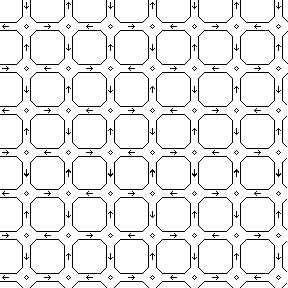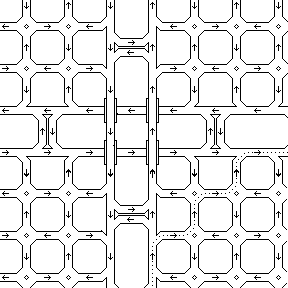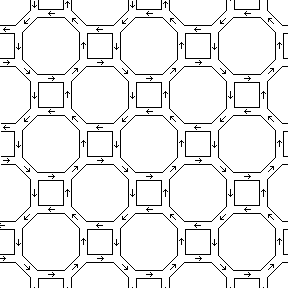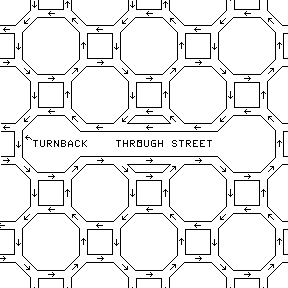The current methods of laying out cities bases traffic design on stopping traffic instead of moving it. This leads to many problems, including congestion, increased pollution, and increased fuel consumption. This page deals with these problems, and possible solutions.
First, the current problems must be dealt with. Here is a list of a few facts that cover the situation:
- Over half of the accidents, and all of the congestion, are the faults of the road.
- Stop signs waste more fuel than any other traffic feature. Traffic lights are the second biggest wasters, and sharp curves are third. High speed limits are way down on the list. Any time a vehicle is stopped and then accelerated, much fuel is wasted.
- A car uses more gas with repeated stops in a line at a stop sign, than it uses going around a block without stopping.
- Auto engines produce the most pollution in stop-start driving. Acceleration and idling are the two most polluting operations a gasoline engine does.
- Any place two traffic movements cross each other, a stop sign, a traffic light, or an overpass is necessary. Only the overpass does not impede traffic flow.
- Drivers tend to speed between stop points more than they would if there were no stops.
- Politicians are the worst people to have making traffic decisions.
- Too often, traffic control decisions are made for reasons other than moving traffic safely.
- Traffic calming devices can impede passage of fire engines.
- Street layouts are designed with property lines in mind, instead of optimum traffic flow.
- High gasoline prices expose the bad design practices used today for street and road design.
- Pedestrians have trouble telling when it is safe to cross.
Other factors:
- Left turn phasing is not necessary at the intersection of two one-way streets.
- Crossing movements can be eliminated by having drivers go around a block.
- Contrary to popular opinion, a business on a one-way street does not get only half of the business it would on a two-way street. In fact, it usually has slightly more business if it is on a one-way street. This is because drivers do not have to wait to make turns across other traffic. Many drivers do tend to choose businesses on the right side of two-way highways.
The solution is to design the city to provide for a constant flow of traffic, with the only stops being under emergency rather than normal conditions. Here are the elements of design necessary for a constant flow of traffic:
- No vehicle crossing movements are allowed.
- All streets are one-way. A properly spaced pair of 2 lane one-way streets can handle twice the traffic as the same two streets can handle when operated as two-way streets in a typical city environment.
- Sufficient spacing exists for proper merging and weaving to occur.
- No weaving of major movements is used unless the weaving distance is over a mile long.
- On-street parking is prohibited on major roads.
- No stop signs or traffic lights are used.
- Yield signs are used only where merging or weaving cannot handle the traffic, or where pedestrians need gaps in traffic.
- All pedestrian crossings are across one-way traffic.
- All streets are at least 2 lanes wide, plus extra lanes for parking where permitted.
- Traffic rules and speed limits should always be set by engineers, never by politicians.
A SOLUTION
Here is an example using a standard grid city block system. Notice these important facts:
- Each street is at least two lanes wide.
- All streets are one-way.
- The direction of each street reverses in each block.
- Travel is accomplished in zigzag fashion in a diagonal direction.
- At each intersection, a right or left turn is required.
- Separate lanes exist for the right and left turn movements.
- After the turn, there are lanes to separately collect the right and left turn movements.
- A sufficiently long weaving section is needed between intersections.
- One disadvantage is that a trip is appreciably longer than in a conventional city.
- Pedestrians cross to the center island at an intersection, then to the desired corner. This requires them to cross only one lane at a time.
- All pedestrian crossings are across one-way traffic.
- Turning radii at the intersections must be able to handle large trucks and fire engines.
- Any attempt to make a movement not provided is also an attempt to enter a one-way street in the wrong direction.
- The system is improved by the modifications below.

Rectangular grid free flow system
ADDING TO THE SOLUTION
Here is a much needed improvement, incorporating a through street every ten blocks or so. Notice how the facts are different for the through street:
- The through street does not reverse direction in each block, but the minor streets do.
- Each minor street is at least two lanes wide.
- The through street is at least 4 lanes wide in the dual weaving sections, and 3 lanes wide between the dual weaving sections and the turnbacks.
- Travel is accomplished in zigzag fashion in a diagonal direction to reach a through street, and to get to the destination from a through street.
- Travel on the through street is straight and unimpeded.
- The movement to get across the through street is shown in dots (.....).
- No turns are required on the through street except to exit to a minor street.
- On the minor streets, a right or left turn is required at each intersection.
- Separate lanes exist for each through, right, or left turn movement.
- After the turn, lanes separately collect the through, right, and left turn movements.
- A sufficiently long weaving section is needed between intersections.
- The through street needs longer weaving sections. Moving the turnbacks accomplishes this. The back-to-back turnbacks provide the longest possible weaving section.
- The through street has the properties of an at-grade expressway with turnbacks.
- The trip is longer only at the ends when the driver is not on through streets.
- Through traffic is kept off the local streets by the reversing one-ways.
- Pedestrians cross to the center island at an intersection, then to the desired corner.
- All pedestrian crossings are across one-way traffic.
- Pedestrian bridges are used to cross the expressways (or see below).
- Turning radii at the intersections must be able to handle large trucks and fire engines.
- Any attempt to make a movement not provided is also an attempt to enter a one-way street in the wrong direction.

Rectangular grid with through street
A FULL SPEED JUNCTION
Where two through streets cross, a junction must be created. The junction shown is for high-volume arterial streets:
- The streets have the same numbers of lanes as is discussed above.
- The through streets do not reverse direction.
- The direction of each minor street reverses in each block.
- Travel is accomplished in zigzag fashion in a diagonal direction on minor streets only.
- Turns from one through street to the other are made indirectly through side streets.
- The left turn from one through street to the other follows a cloverleaf type loop.
- The right turn can be made either through a turnback and a left turn loop, or through a zigzag. A typical right turn is shown in dots.
- A full interchange can be inserted if necessary.
- Separate lanes exist for through, right, and left turn movements.
- After the turn, lanes separately collect through, right, and left turn movements.
- A sufficiently long weaving section is needed between intersections.
- The through street needs longer weaving sections. Moving the turnbacks accomplishes this. The back-to-back turnbacks provide the longest possible weaving section.
- The overpass doubles the length of the weaving section.
- The through streets have the properties of at-grade expressways with turnbacks.
- The trip is longer only at the ends when the driver is not on through streets.
- Through traffic is kept off the local streets by the reversing one-ways.
- The overpasses can be replaced with traffic lights at low volume intersections, but the constant flow is lost.
- Pedestrians cross to the center island at an intersection, then to the desired corner.
- All pedestrian crossings are across one-way traffic.
- Pedestrians use the overpasses and underpasses to cross the through streets.
- Turning radii at the intersections must be able to handle large trucks and fire engines.
- Any attempt to make a movement not provided is also an attempt to enter a one-way street in the wrong direction.

Rectangular free flow junction
A BETTER SOLUTION
The grid above can be rotated 45 degrees, and the islands at the intersections enlarged to block size to produce this octagonal system. Notice these important facts:
- Each diagonal street is at least two lanes wide.
- Each street on the boundary of a square is at least one lane wide.
- All streets are one-way.
- The direction of each street does not reverse in each block in this system.
- Travel is accomplished in a meandering fashion in the general direction.
- At each intersection, a shallow right or left turn is required.
- Separate lanes exist for the right and left turn movements.
- After the turn, there are lanes to separately collect the right and left turn movements.
- A sufficiently long weaving section is needed between intersections.
- An alternative to the weaving sections is to treat each counterclockwise rotating octagon as a roundabout.
- One disadvantage is that a trip is somewhat longer than in a conventional city, but not as long as the trip in the first diagram is.
- Pedestrians cross the narrower sections of street. This requires them to cross only one lane at a time.
- All pedestrian crossings are across one-way traffic.
- Turning radii at the intersections easily handle large trucks and fire engines.
- Operating speeds are generally higher unless parking interferes.
- Any attempt to make a movement not provided is also an attempt to enter a one-way street in the wrong direction.
- The biggest disadvantage is the creation of odd-shaped parcels of land.
- The system is improved by the modifications below.

Octagonal grid free flow system
ADDING TO THE BETTER SOLUTION
Here is an improvement, incorporating a through street every ten blocks or so. Performance is improved even more on the through street:
- The direction of each street does not reverse in each block in this system.
- Each diagonal street is at least two lanes wide.
- Each street on the boundary of a square is at least one lane wide.
- All streets are one-way.
- The through street is at least 4 lanes wide in the weaving sections.
- Travel is accomplished in a meandering fashion to reach a through street, and to get to the destination from a through street.
- Travel on the through street is straight and unimpeded.
- No turns are required on the through street except to exit to a minor street.
- On the minor streets, a shallow right or left turn is required at each intersection.
- Separate lanes exist for each through, right, or left turn movement.
- After the turn, lanes separately collect the through, right, and left turn movements.
- A sufficiently long weaving section is needed between intersections.
- An alternative to the weaving sections is to treat each counterclockwise rotating octagon as a roundabout.
- The through street needs longer weaving sections.
- The through street has the properties of an at-grade expressway with turnbacks.
- Eliminating some of the turnbacks lengthens the weaving sections.
- The trip is slightly longer only at the ends when the driver is not on through streets.
- Through traffic is kept off the local streets by the meandering.
- Pedestrians cross the narrower sections of street. This requires them to cross only one lane at a time.
- All pedestrian crossings are across one-way traffic.
- Pedestrian bridges are used to cross the expressways (or see below).
- Turning radii at the intersections easily handle large trucks and fire engines.
- Operating speeds are generally higher unless parking interferes.
- Any attempt to make a movement not provided is also an attempt to enter a one-way street in the wrong direction.
- The biggest disadvantage is the creation of odd-shaped and narrow parcels of land.

Octagonal grid with through street
POWER JUNCTION
Where two through streets cross, a junction must be created. The junction shown is for high-volume arterial streets in the octagonal system:
- The streets have the same numbers of lanes as is discussed above.
- The streets do not reverse direction.
- Travel is accomplished in a meandering fashion on minor streets only.
- Turns from one through street to the other are made indirectly through side streets.
- The left turn from one through street to the other follows a cloverleaf type loop.
- The right turn is made through meanders. The typical right turn is shown in dots.
- A full interchange can be inserted if necessary.
- Separate lanes exist for through, right, and left turn movements.
- After the turn, lanes separately collect through, right, and left turn movements.
- A sufficiently long weaving section is needed between intersections.
- An alternative to the weaving sections is to treat each counterclockwise rotating octagon as a roundabout.
- The through street needs longer weaving sections.
- The loops have the ability to combine to function as turnbacks, eliminating the need for separate turnbacks near the junction.
- The overpass doubles the length of the weaving section.
- The through streets have the properties of at-grade expressways.
- The trip is slightly longer only at the ends when the driver is not on through streets.
- Through traffic is kept off the local streets by the meanders.
- The overpasses can be replaced with traffic lights at low volume intersections, but the constant flow is lost.
- Pedestrians cross the narrower sections of street. This requires them to cross only one lane at a time.
- All pedestrian crossings are across one-way traffic.
- Pedestrians use the overpasses and underpasses to cross the through streets.
- Turning radii at the intersections easily handle large trucks and fire engines.
- Operating speeds are generally higher unless parking interferes.
- Any attempt to make a movement not provided is also an attempt to enter a one-way street in the wrong direction.
- The biggest disadvantage is the creation of odd-shaped and narrow parcels of land.

Octagonal free flow junction